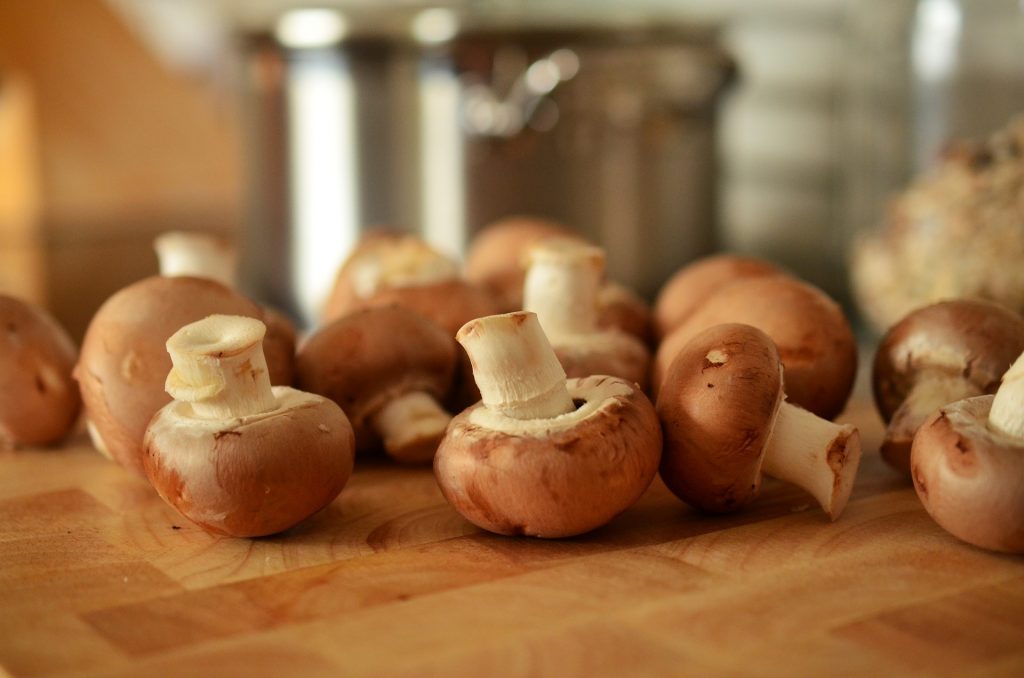 Much has been made of the vitamin D content of ultraviolet irradiated mushrooms. And for good reason, as mushrooms can be an excellent source of vitamin D2 (ergocalciferol). However, mushrooms have been shown to be a good source of a number of other nutrients and in this regard they could be considered a high quality food that should be incorporated as part of a healthy diet. As with all foods, mushrooms vary in their nutritional composition depending on growing conditions and the variety of mushroom being considered. The edible parts of mushrooms are the fruiting bodies, which are the well recognised cap and stalk that are available in supermarkets. Exposure of this part of the mushroom to sunlight increases the vitamin D content considerably, and so wild mushrooms are much richer in vitamin D compared to cultivated mushrooms, due to increased sunlight exposure. Consumption of wild mushrooms can significantly increase vitamin D blood levels and prevent vitamin D deficiencies.
Much has been made of the vitamin D content of ultraviolet irradiated mushrooms. And for good reason, as mushrooms can be an excellent source of vitamin D2 (ergocalciferol). However, mushrooms have been shown to be a good source of a number of other nutrients and in this regard they could be considered a high quality food that should be incorporated as part of a healthy diet. As with all foods, mushrooms vary in their nutritional composition depending on growing conditions and the variety of mushroom being considered. The edible parts of mushrooms are the fruiting bodies, which are the well recognised cap and stalk that are available in supermarkets. Exposure of this part of the mushroom to sunlight increases the vitamin D content considerably, and so wild mushrooms are much richer in vitamin D compared to cultivated mushrooms, due to increased sunlight exposure. Consumption of wild mushrooms can significantly increase vitamin D blood levels and prevent vitamin D deficiencies.
The carbohydrate content of mushrooms is about 15 to 65 % of the dry mass, with sugars such as mannitol (0.3 to 5.5 % dry mass) and glucose (0.5 to 3.6 % dry mass) as well as glycogen (1.0 to 1.6 % dry mass) being present. However, a large proportion of the carbohydrate is present as low molecular weight starch (oligosaccharides) and non-starch polysaccharides such as chitin, β-glucans and mannans. Mushrooms are also a good source of protein, with the protein component considered to generally be of higher quality than plant protein. The protein content of mushrooms is about 12 to 29 %, although this can rise to 60 % in some mushrooms. The quality of protein in mushrooms is higher than soy and has been found to be comparable to egg protein in some cases. Some studies show the ratio of essential to nonessential amino acids to be between 0.45 and 0.77, which compared well to the World Health Organisation recommendation of 0.6. Mushrooms are therefore a good source of protein and carbohydrates.

Mushrooms are reasonable source of antioxidants. Like plants they contain a number of polyphenolic compounds that may confer antioxidant protection to those that eat them. The main polyphenolics in mushrooms include quercetin, catechin, p-coumaric acids, caffeic acid and gallic acid. Ergothioneine is a water-soluble thiol compound found in mushrooms, and it may possess significant antioxidant potential. Mushrooms also contain vitamin E as tocopherols, which are fat soluble antioxidants in humans. Mushrooms are therefore a good source of antioxidants. However, as they tend not to be eaten as commonly as fruits and vegetables, in reality they probably contribute only a small amount to the total antioxidant intake in most humans. As with plants, the method of growing and preparation can have a significant impact on the amount of antioxidants that are bioavailable to the consumer.
The lipid content of mushrooms is low and ranges from about 1 to 7 %. The fat content of the mushrooms is as palmitic, oleic and stearic acids, although mushrooms do contain the essential fatty acid linoleic acid as well. Mushrooms are therefore a source of both saturated and unsaturated fatty acids. Mushrooms also contain ergosterol, which is the precursor to vitamin D, and vitamin D itself. Mushrooms also contain a number of essential minerals, but these are obtained from the food of the fungi in question and so the amounts will depend on the growing conditions of the mushrooms. Minerals may include phosphorus, potassium, sodium, calcium, magnesium, iron, manganese and zinc. Other minerals are likely present, but are either in low amounts not detectable to researchers, or have not been analysed. Vitamins detected in mushrooms include the B vitamins thiamine, riboflavin and niacin as well as vitamin E (as tocopherols) and as previously mentioned, vitamin D.
Eat Well, Stay Healthy, Protect Yourself
RdB
